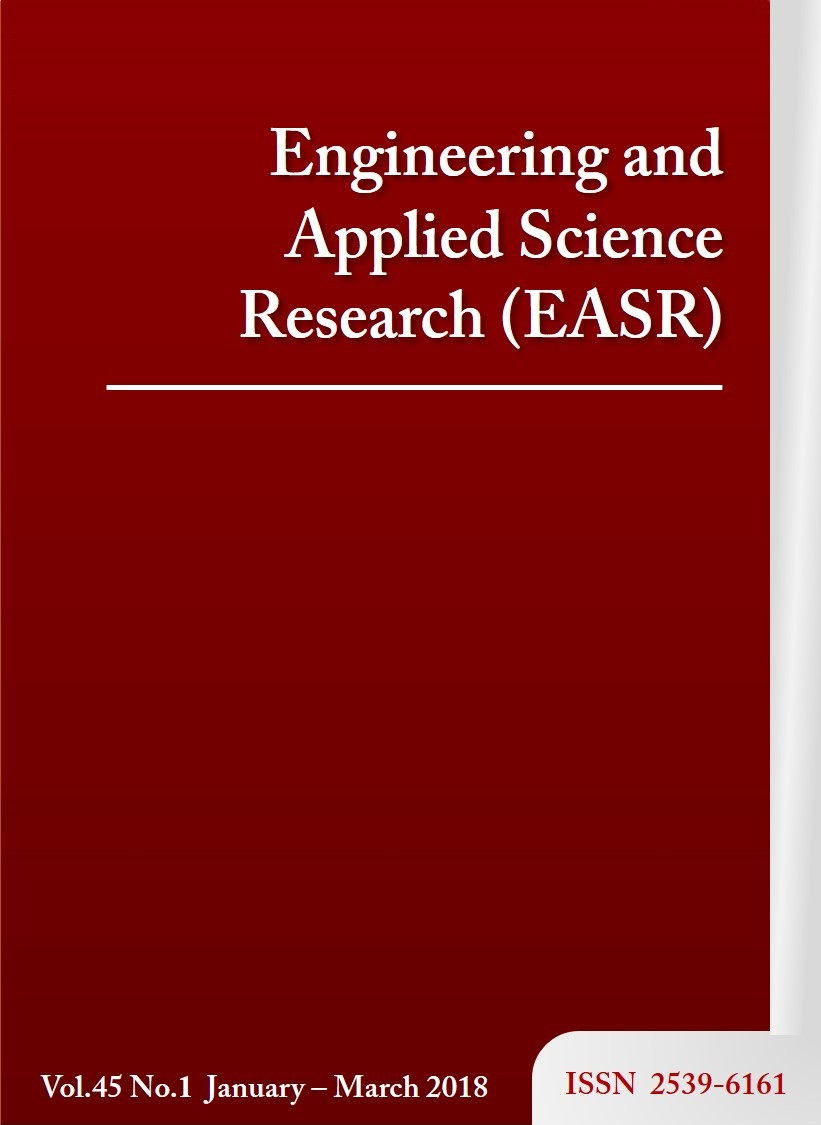Performance and emissions characteristics of a direct injection diesel engine from compressing producer gas in a dual fuel mode
Main Article Content
Abstract
This research highlights the impact of compressed producer gas combined with diesel fuel in a dual fuel mode on performance and emission characteristics of a three-cylinder diesel engine connected to an AC generator. Producer gas was generated from a small downdraft gasifier using charcoal, and sent into the engine using a supercharger to increase the gas flow rate from 76 to 125 lpm. The engine speed was adjusted from 1,000 to 1,600 rpm, while operating at full load. All results of this investigation indicate that supercharging producer gas improved the diesel economy and engine performance characteristics, but it increased the amount of various pollutants. Engine performance testing results from compressing producer gas showed that the use of gas flow rates of 116 to 125 lpm increased the maximum diesel saving by 41%, electrical power by 1.88%, and thermal efficiency by 35.76% as compared to a diesel fuel only mode. Additionally, specific energy consumption decreased with increasing producer gas flow rate and engine speed. For measuring the emissions of the engine, exhaust gas temperature increased from 223 to 276 oC, CO2 emissions increased from 21.59 to 33.90%, CO emissions increased from 0.36 to 0.59%, HC emissions increased from 23 to 58 ppm, and smoke opacity increased from 4.00 to 6.07 K.m-1 compared with the diesel fuel only mode.
Article Details
This work is licensed under a Creative Commons Attribution-NonCommercial-NoDerivatives 4.0 International License.
References
Reference
Shaw D, Akhtar SJ, Priyam A, Singh RK. Performance study of dual fuel engine using producer gas as secondary fuel. Carbon-Science and Technology 2016; 8(2):63-71.
Yadav JP. Performance analysis of producer gas based diesel engine. International Journal of Engineering Innovation & Research 2013; 2(1):42-48.
Shrivastava V, Jha AK, Wamankar AK, Murugan S. Performance and emission studies of a ci engine coupled with gasifier running in dual fuel mode. Procedia Engineering 2013; 51:600-608.
Rith M, Biona JBM, Gitano-Briggs HW, Sok P. Performance and emission characteristics of the genset fuelled with dual producer gas-diesel. the DLSU Research Congress 2016; 4:1-7.
Brenneisen PJ, Chavez LI, Avaci AB, Nogueira CEC, Secco D, Ricieri RP, Bariccatti RA. Performance of diesel cycle engine-generator operating on dual fuel mode with gasification gas. African Journal of Biotechnology 2013; 12(10):1148-1154.
Dasappa S, Sridhar G, Sridhar HV, Rajan NKS, Paul PJ, Upasani A. Producer gas engines-proponent of clean energy technology. Proceedings of the 15th European Biomass Conference & Exhibition; 2007 May 7-11; Berlin, Germany.
Homdoung N, Tippayawong N, Dussadee N. Performance and emissions of a modified small engine operated on producer gas. Energy Conversion and Management 2015; 94:286-292.
Sombatwong P, Thaiyasuit P, Pianthong K. Effect of pilot fuel quantity on the performance and emission of a dual producer gas diesel engine. Energy Procedia 2013; 34:218-227.
Lekpradit T, Tongorn S, Nipattummakul N, Kerdsuwan S. Study on advanced injection timing on a dual-fuel diesel engine with producer gas from a down-draft gasifier for power generation. Journal of Metals, Materials and Minerals 2008; 18(2):169-173.
Yaliwal VS, Banapurmath NR, Revenakar S, Tewari PG. Effect of mixing chamber or carburetor type on the performance of diesel engine operated on biodiesel and producer gas induction. International Journal of Automotive Engineering and Technologies 2016; 5(2):25-37.
Hadkar T, Amarnath HK. Performance and emission characteristics of producer gas derived from coconut shell (biomass) and honne biodiesel with different configuration of carburetor for dual fuel four stoke direct injection diesel engine. International Research Journal of Engineering and Technology 2015; 2(3):1804-1811.
Banapurmath NR, Tewari PG. Comparative performance studies of a 4-stroke CI engine operated on dual fuel mode with producer gas and honge oil and its methyl ester (HOME) with and without carburetor. Renewable Energy 2009; 34:1009-1015.
Hassan S, Zainal ZA, Aizat S, Miskam MA. The effects of supercharging on the performance and exhaust gas emissions of a dual-fuel engine fueled with producer gas-diesel and palm oil blends. Middle-East Journal of Scientific Research 2011; 7(2):162-169.
Nayak C, Acharya SK. Experimental investigation of diesel engine emissions with producer gas and blends of neat karanja oil as fuel adding turbocharger. International Journal of Renewable Energy Research 2014; 4(3):675-682.
Nayak C. Effect of blends of karanja oil on performance of a twin cylinder dual fuel diesel engine using producer gas. IOSR Journal of Mechanical and Civil Engineering 2014; 10(5): 56-63.
Bargat SP, Wagh PS, Kakde UA. Application of wood chip producer gas and bio-diesel blends in CI engine. International Journal of Engineering Research & Technology 2012; 1(3): 1-6.
Martyr AJ, Plint MA. Engine testing theory and practice. Butterworth-Heinemann: Oxford; 2007.
Heywood JB. InternalCombustion Engine Fundamental. McGraw –Hill: New York; 1988.
Kumar P, Garg L, Kumar R, Mohapatra SK. Performance parameters of dual fuel diesel engine using eucalyptus–producer gas as secondary fuel. International Journal of Engineering Technology Science and Research 2015; 2:15-22.



